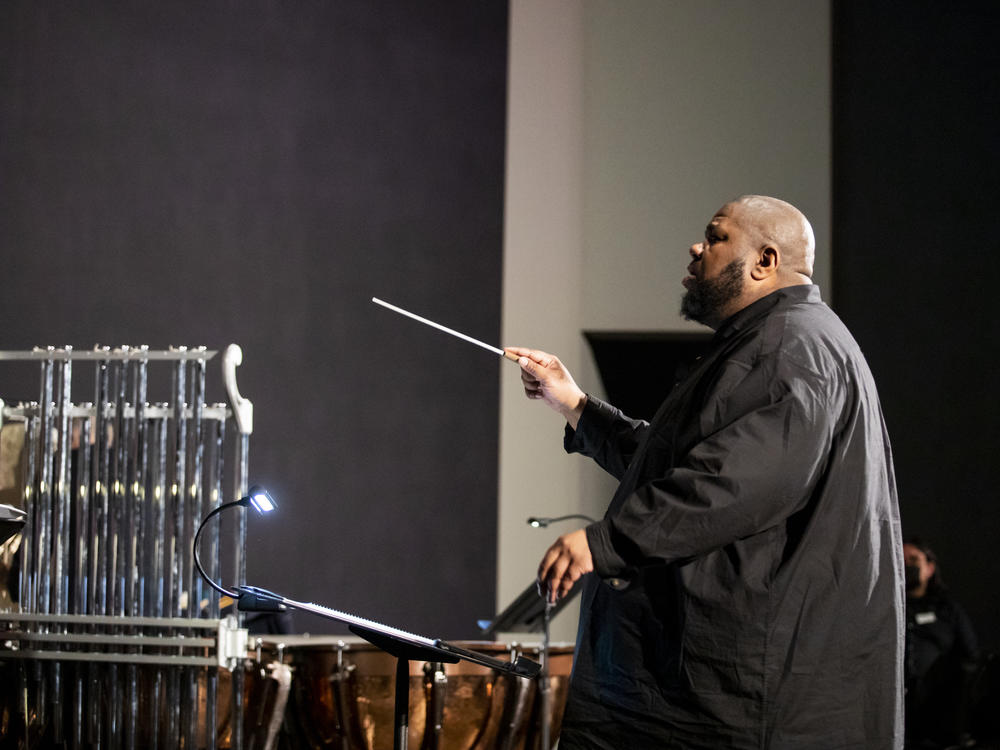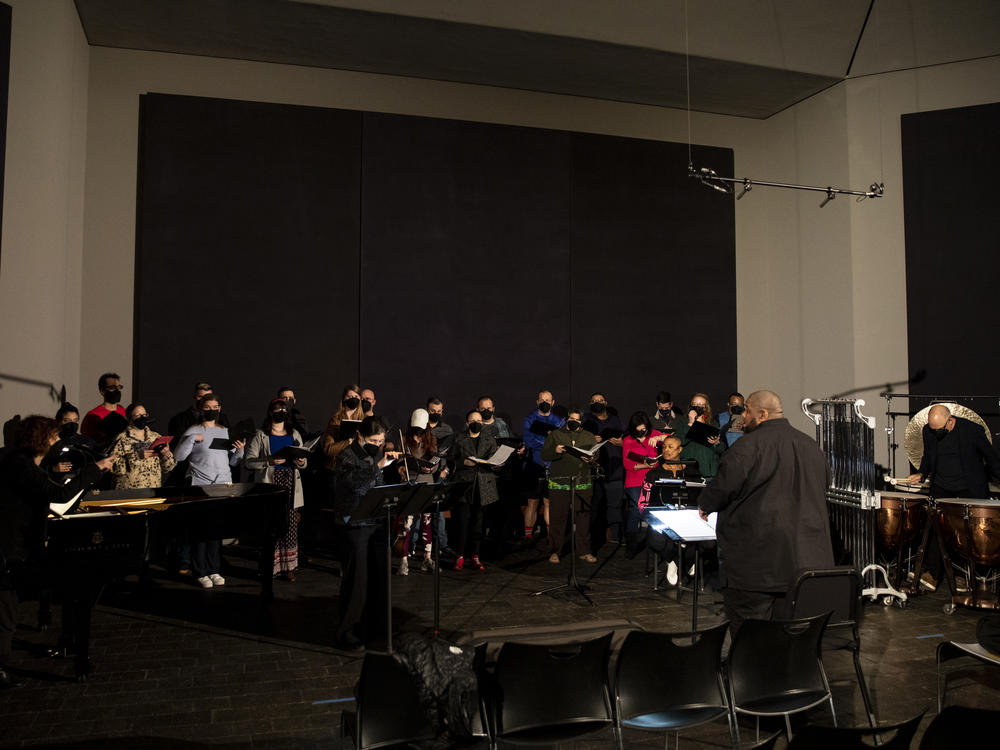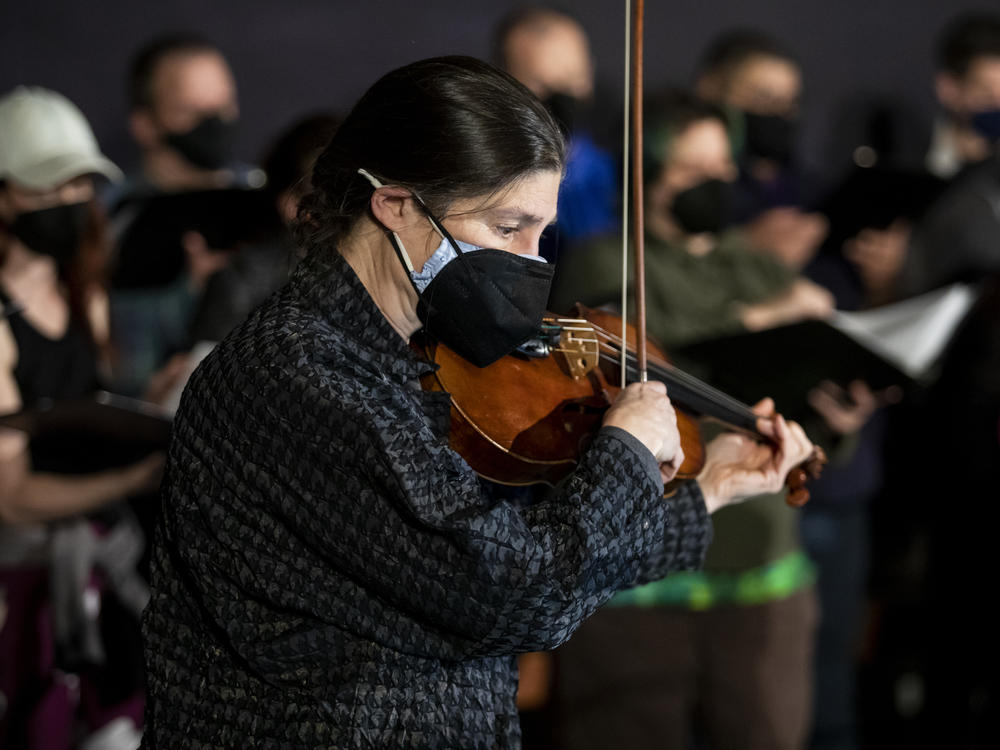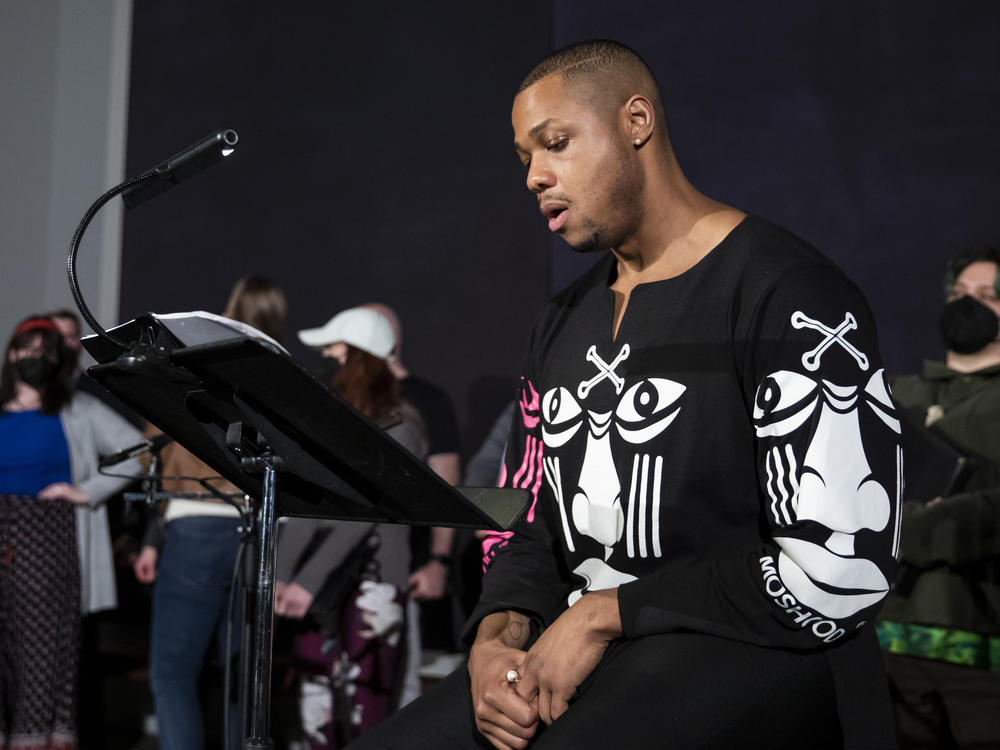Section Branding
Header Content
At the Rothko Chapel, Tyshawn Sorey explores sound — and silence
Primary Content
Fifty years ago, composer Morton Feldman wrote music to commemorate the opening of the Rothko Chapel in Houston. A half-century later, composer, conductor, multi-instrumentalist and MacArthur "genius" Tyshawn Sorey was asked to write a new piece for this nondenominational space. Sorey's Monochromatic Light (Afterlife) debuted Feb. 19 at the Rothko Chapel.
The Rothko Chapel is a mysterious space, one that invites deep contemplation. David Leslie is the chapel's executive director. He says that as soon as you walk in from a bright, sunny Houston day, through a series of doors into this hushed, dark place, your mind and your body are both forced to shift into a very different, holy space.
"Then you walk into the sanctuary, the inner sanctum, and suddenly what you're struck by is not a large space," Leslie observes, "but this real sense of lightness of being."
The dome of the chapel is a skylight that allows the natural light to fall upon 14 massive, dark panels painted by American artist Mark Rothko. Sorey says that he hopes his music gives listeners the same feeling of being enveloped, in the same way that Rothko's huge paintings provide.
"As he said, if you're looking at a small picture, you're sort of outside of the experience," Sorey says. "When you're looking at a large picture, you're sort of engulfed in that experience. You're immersed in that experience."
At first glance, the panels can look flat, nearly black. But as you sit with them for a while, you start noticing so much else. This suite of paintings were some of Rothko's last work, and he never saw them in the space himself. Rothko's spirit and intention are everywhere here, Sorey notes.
"You get a sense that there's a lot of activity that's happening — the expression of time, the expression of movement. ... And these sort of humanistic qualities that went into these paintings, the brushstrokes, the gradations of color. So there's activity going on there," Sorey says.
"At the same time," he says, "there's a sort of inaction that's there as well. The painting is the painting itself. Is it moving? No, it's not doing anything. The change that is really happening is in that skylight that's on the top of the chapel where the light is changing. Every minute, there's something about the colors of those panels that's changing. And it's revealing something else, it's revealing another shade of that color or is revealing more of this activity or less of this activity."
With Morton Feldman as one of his longtime compositional heroes — alongside the likes of Roscoe Mitchell and Bill Dixon — Sorey decided to use a similar set of musical forces to that used by Feldman some 50 years ago. For his Rothko Chapel, Feldman employed percussion, celesta, viola, choir and soprano; Sorey added a piano and swapped the soprano soloist for a darker-voiced bass-baritone.
"I have long been attracted to Mark Rothko's work as well for a very, very long time," Sorey says. "These are two of my biggest influences in the work that I've been doing. And so for me, this commission gave me the opportunity to contribute to a legacy."
In the space of Rothko Chapel, hearing Sorey's music, you become part of this massive entity that is much larger than yourself, says violist Kim Kashkashian, one of the soloists in Monochromatic Light (Afterlife).
(Kashkashian, like two fellow soloists — percussionist Steven Schick and pianist and celesta player Sarah Rothenberg — are also closely associated with Feldman's Rothko Chapel, which they recorded together for a critically acclaimed ECM Records album released in 2015.)
"If you are willing to sit down and listen to this 50-minute work," Kashkashian says of Sorey's piece, "it is in one way like a meditation because there's a lot of repetition in it. Every time something gets repeated, I think that the spirit changes. And it should change in you as a listener, too."
Kashkashian adds, however, that Monochromatic Light (Afterlife) is anything but gauzy. "The emotion that is evoked by the piece is not sentimental," she says. "So it's a very strong work. I envision a kind of wise and stern angel telling all of this story from all various aspects."
The piece is full of mystery, with floating, unsettled harmonies. The vocalists — the Houston Chamber Choir and solo bass-baritone Davóne Tines sing in wordless syllables. Percussion thunders.
As an instrumentalist, the wide-ranging Sorey is best known as a drummer and percussionist. Steven Schick is the percussionist in Monochromatic Light (Afterlife); he notes that you can hear Sorey's thinking as a fellow percussionist in this work.
"There are long moments in which there are huge arcs of time, that things move slowly," Schick observes, "and then suddenly there will be a crystalline event, something that changes the trajectory and changes the entire ecosystem of the piece. And I'm not saying that only a percussionist could have done that, but I sense the percussionist in Tyshawn when I hear him manage time that way."
Schick also sees a strong connection between the visual and the sonic in Sorey's work. "The piece is about light," Schick says. "Rothko Chapel in itself is about light. But light is vibration, just as sound is. And so I realized that we're on this big spectrum where at the most rapid possible level, you get colors of light. And at the slowest possible level, you have these large-scale formal or temporal structures that comprise the music. We're asked to negotiate the spectrum kind of fluidly, from the largest pulses to the very, very smallest pulses — really, in essence, from form to colored light."
Sorey also makes plenty of room for silence in Monochromatic Light (Afterlife). "We're at a period now where there's sort of an anxiety to that — there's an anxiety of silence, I think," he observes. "I'm not afraid of it at all. And I choose to exploit it in almost every single thing I do because I think that that's just as important as what does come out of the instruments."
"Sometimes you may hear a melody in the viola that may somehow reappear in the bass or something," Sorey continues, "but then there'll be a lot of breaks in between, to have the listener reflect on what was just heard and not think about what's going to come next — but only be in that moment. It's almost like you're moving around a room and you're moving about the room in a silent sort of way, so you can be immersed in each moment that you go to."
Along with playing piano and celesta in Monochromatic Light (Afterlife), Sarah Rothenberg is the artistic director of DACAMERA, the presenting organization in Houston that, along with the Rothko Chapel, commissioned Sorey's piece. She says this new work reflects the pandemic times, and a hunger for connection.
"We've all lived through a kind of collective trauma, and we've all felt more than ever, I think, our own individual vulnerability," Rothenberg says. "And yet at the same time, we're living in a world where there's a tremendous amount of aggression around us and aggressive behavior, and it sometimes feels like the social fabric that holds us together is falling apart. This music has tremendous emotion in it, but it never has any aggression in it. I think it's a very brave piece because of its vulnerability. And I think that's what we need right now."
Sorey also invokes much older, and continuing, pain and Black experience in the U.S. Near the end of composer Morton Feldman's 1971 piece Rothko Chapel, a melody bubbles up for the viola — one that Feldman called "quasi-Hebraic." It evoked Feldman and Rothko's shared Jewish heritage. In his piece, Sorey uses an abstracted version of the spiritual "Sometimes I Feel Like A Motherless Child."
Sorey says utilizing "Motherless Child" is a way of talking musically about generational trauma — just, as he says, Feldman did in his own work with that "quasi-Hebraic melody." He also points out that spirituals have been part of the underpinning of some of his other recent works as well, including Cycles of My Being, Save the Boys and Death.
" 'Sometimes I Feel Like a Motherless Child' is a hymn that I've always heard coming up in the church, and it is one that I can very much relate to in a lot of ways," Sorey says. "I've heard it sung many a time. It's a hymn that is always spoken to me. And so I just decided to have that be one of the driving aspects of the composition."
Sorey's piece was written for the Rothko Chapel, but it will have a life beyond that space. Monochromatic Light (Afterlife) will be recorded for the ECM label later this year, and it will be performed this fall at the Park Avenue Armory in New York City, in a new staging to be directed by Peter Sellars.
Copyright 2022 NPR. To see more, visit https://www.npr.org.




